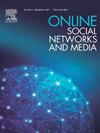SPREADSHOT: Analysis of fake news spreading through topic modeling and bipartite weighted graphs
IF 2.9
Q1 Social Sciences
引用次数: 0
Abstract
Spreading of fake news is one of the primary drivers of misinformation in social networks. Graph-based approaches that analyze fake news dissemination are mostly dedicated to fake news detection and consider homogeneous tree-based networks obtained by following the diffusion of single messages through users, thus lacking the ability to identify implicit patterns among spreaders and topics. Alternatively, heterogeneous graphs have been proposed, although the detection remains their main goal and the use of graph centralities is rather limited. In this paper, bipartite weighted graphs are used to analyze fake news and spreaders by utilizing topic modeling and a combination of network centrality measures. The proposed architecture, called SPREADSHOT, leverages a topic modeling technique to identify key topics or subjects within a collection of fake news articles published by spreaders, thus generating a bipartite weighted graph. By projecting the graph model to the space of spreaders, one can identify the strengths of links between them in terms of fakeness correlation on common topics. Moreover, the closeness and betweennes centralities highlight spreaders who represent key enablers in the dissemination of fakeness on different topics. The projection of the bipartite graph to the space of topics allows one to identify topics which are more prone to misinformation. By collecting specific network measures, a synthetic fakeness networking index is defined which characterizes the behaviors and roles of spreaders and topics in the fakeness dissemination. The effectiveness of the proposed technique is demonstrated through tests on the LIAR dataset.
SPREADSHOT:通过主题建模和二部加权图分析假新闻传播
假新闻的传播是社交网络中错误信息的主要驱动因素之一。分析假新闻传播的基于图的方法大多致力于假新闻检测,并考虑通过跟踪单个消息在用户中的扩散而获得的同质树状网络,因此缺乏识别传播者和主题之间隐含模式的能力。另外,异质图也被提出,尽管检测仍然是他们的主要目标,而且图中心性的使用相当有限。本文采用主题建模和网络中心性测度相结合的方法,利用二部加权图对假新闻及其传播者进行分析。所提出的架构称为SPREADSHOT,利用主题建模技术来识别传播者发布的假新闻文章集合中的关键主题或主题,从而生成二部加权图。通过将图模型投射到传播者的空间,可以根据共同话题的虚假相关性来识别它们之间的链接强度。此外,中心性之间的接近性突出了传播者,他们代表了在不同主题上传播虚假的关键推动者。二部图到主题空间的投影允许人们识别更容易产生错误信息的主题。通过收集具体的网络测度,定义一个综合的虚假网络指数,表征传播者和话题在虚假传播中的行为和作用。通过对LIAR数据集的测试,证明了该方法的有效性。
本文章由计算机程序翻译,如有差异,请以英文原文为准。
求助全文
约1分钟内获得全文
求助全文
来源期刊

Online Social Networks and Media
Social Sciences-Communication
CiteScore
10.60
自引率
0.00%
发文量
32
审稿时长
44 days
 求助内容:
求助内容: 应助结果提醒方式:
应助结果提醒方式:


